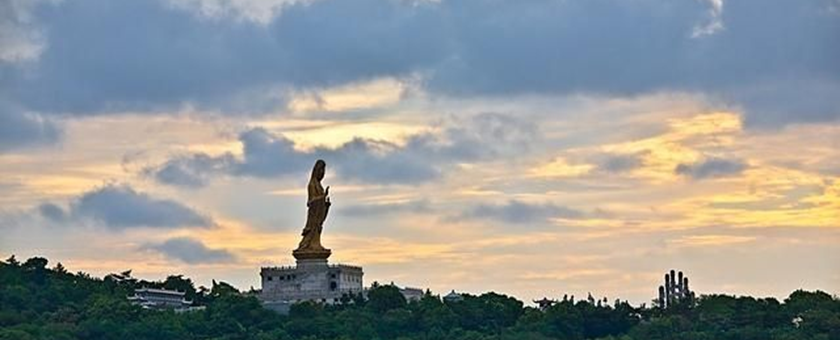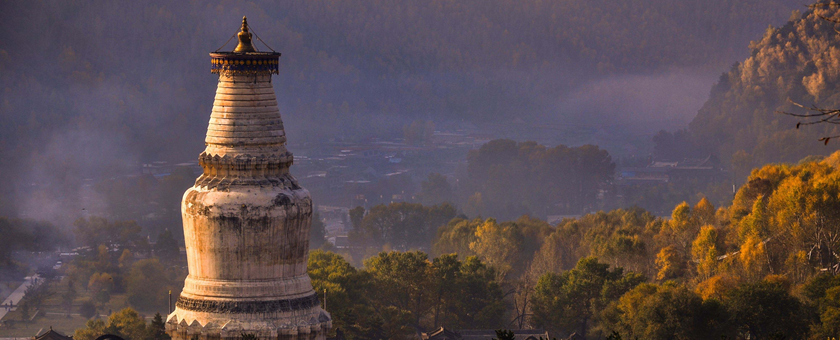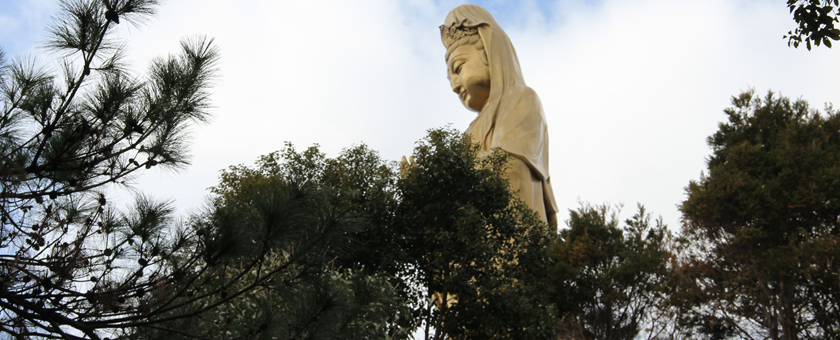- info@chinaadventure.org
- 86-18008011324
- Search
Buddhism is one of the three major religions in the world. With the introduction of Buddhism, since the Han Dynasty, some eminent monks have been searching the mountains and building temples and ashrams in China, which continues to this day. The famous Buddhist mountains include Mount Wutai in Shanxi Province, Mount Putuo in Zhejiang Province, Mount Emei in Sichuan Province, Mount Jiuhua in Anhui Province and Mount Xuedou in Zhejiang Province, which are known as the "five famous Buddhist mountains in China".
In addition, there are eight famous Buddhist mountains passed down through the ages, which are: Wolf Mountain in Jiangsu Province, Hengshan Mountain, Songshan Mountain, Lushan Mountain in Jiangxi Province, Jifu Mountain in Yunnan Province, Tiantai Mountain in Eastern Zhejiang Province, Zhongnan Mountain in Shaanxi Province, and Xiangshan in Beijing.

Mount Wutai
Mount Wutai is the most sacred place of Buddhism in China. Wutai County, Shanxi Province, three thousand meters above sea level, surrounded by five mountains, whose peaks are flat and wide, thus its name.. Since the Han and Tang Dynasties, Mt. Wutai has been the center of Buddhism in China. Since then, it has been built many times, with more than 300 temples in its heyday. By 2014, most of the monasteries were gone, leaving only 39 inside and eight outside. Mount Wutai is one of the national key scenic spots. After continuous renovation, the temple is more magnificent and richer in cultural heritage. Among them, the five most famous Zen temples are Xiantong Temple, Tayuan Temple, Manjusri Temple, Shuxiang Temple and Luohou Temple.
Mount Wutai has been recognized by Buddhism at home and abroad as the ashram of Manjusri Bodhisattva, and became a Buddhist holy place attracting worldwide attention since the Tang Dynasty. Wu Ze Tian, who ascended to the throne, claimed that she had traveled to the five roofs of the Buddha's mind. This was the beginning of Mount Wutai's Buddhism to achieve a pivotal position in the national Buddhist circle.

Mount Putuo
Mount Putuo is one of the four famous Buddhist mountains in China. It is located in Zhoushan Islands, Zhejiang Province. Such a beautiful island with so many cultural relics and historic sites can be said to be unique in our country. Located about 100 nautical miles east of Hangzhou bay, Mt. Putuo is a small island in Zhoushan archipelago, covering an area of about 12.5 square kilometers. The name of Putuo Mountain, from the Buddhist "Hua Yan Sutra" and other 68 volumes, is a translation of Sanskrit, meaning "beautiful little white flower". Because the Chinese emperors in the past Dynasties were most established in the north, since the Yuan Dynasty, people used to call this mountain "South China Sea Putuo". Putuo Mountain as a Buddhist resort, there were 82 monasteries, 128 cottages, more than 4,000 monks and nuns at its peak. Visitors wander the island's footpaths and often come across robeed monks. The beautiful natural scenery and strong Buddhist atmosphere give it a mysterious color, and this kind of color is exactly where it has a strong attraction to tourists.

Mount Emei
Mount Emei is located in Emeishan City, Sichuan Province, covering an area of 154 square kilometers. The highest peak, Wanfengding, is 3,099 meters above sea level. It is a famous tourist resort and a famous Buddhist mountain. It was listed in the world natural and cultural heritage list on December 6, 1996.
Mount Emei is famous for its beautiful natural scenery, time-honored Buddhist culture, rich animal and plant resources, and unique geological features. It is known as "immortal mountain Buddha country", "plant kingdom", "animal paradise", "geological museum" and so on. From ancient to modern times, Mount Emei has been a resort for people to worship Buddha, sightseeing, scientific investigation, leisure and recuperation.
Mount Emei is the Bodhisattva ashram of Pu Xian, one of the four Buddhist shrines in China. It is said that Buddhism was introduced to Mt. Emei in the first century. The development of Buddhism in the past 2,000 years has left a rich Buddhist cultural heritage to Mt. Emei and created many eminent monks with great virtues, making Mt. Emei a Buddhist holy place with profound influence in China and even the world. By the end of 2014, there are about 300 monks and nuns in the mountain, with nearly 30 temples, among which the famous ones are Baoguo temple, Fuhu Temple, Qingyin Pavilion, Hong Chunping, Xiefeng Temple, Xixiang Pond, Jinding Huazang Temple and Wannian Temple.

Mount Jiuhua
Jiuhua Mountain is located in Chizhou City, Anhui Province, 20 kilometers away from Chizhou city Qingyang County, about 60 kilometers away from the south bank of the Yangtze River, with an area of 120 square kilometers and the main peak Shi Wang peak elevation 1344.4 meters. Mount Jiuhua is said to be the ashram of the king of the earth. Mt. Jiuhua with a total of 99 peaks, Tiantai, Shi Wang, Lian Hua, Tianzhu and other 9 peaks are the most magnificent. Mt. Jiuhua Temple forest, is the holy place of worship. Mt. Jiuhua’s beautiful scenery and pleasant climate, make it a tourist summer resort. It has more than 80 temples and more than 300 monks and nuns, which has gradually become a scenic tourist area with Buddhist characteristics. Among the four famous Buddhist mountains in China, Mt. Jiuhua is the most outstanding one for its double crown of "the most fragrant mountain in the world" and "the highest mountain in southeast China".

Mount Xuedou
Xuedou Mountain, a national key scenic spot, national forest park, and national AAAAA scenic spot, is known as "the first mountain in the Siming Dynasty", and is one of the five famous Buddhist mountains in China.
Xuedou Mountain is a Buddhist mountain with a long history and profound cultural accumulation. Famous in the Song Dynasty, it had a history of more than 1700 years. The elementary temple, Xingguo Temple and other nine temples known as the "World Zen ten temples" all over the world, is the root of the Maitreya.

we’ll reply you in 24 hours!
Copyright © 2012-2024 All Rights Reserved to chinaadventure.org